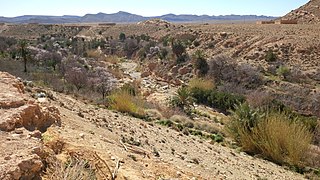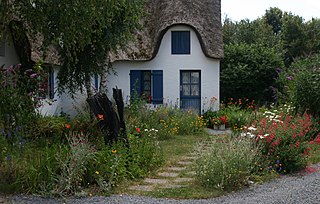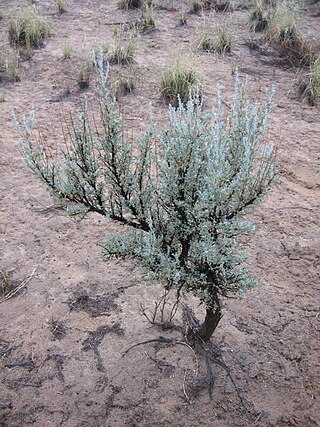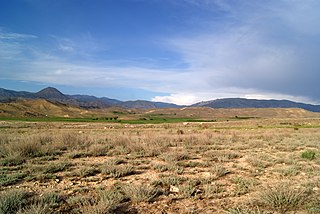Related Research Articles

A grassland is an area where the vegetation is dominated by grasses (Poaceae). However, sedge (Cyperaceae) and rush (Juncaceae) can also be found along with variable proportions of legumes, like clover, and other herbs. Grasslands occur naturally on all continents except Antarctica and are found in most ecoregions of the Earth. Furthermore, grasslands are one of the largest biomes on earth and dominate the landscape worldwide. There are different types of grasslands: natural grasslands, semi-natural grasslands, and agricultural grasslands. They cover 31–69% of the Earth's land area.

Deserts and xeric shrublands are a biome defined by the World Wide Fund for Nature. Deserts and xeric shrublands form the largest terrestrial biome, covering 19% of Earth's land surface area. Ecoregions in this habitat type vary greatly in the amount of annual rainfall they receive, usually less than 250 millimetres (10 in) annually except in the margins. Generally evaporation exceeds rainfall in these ecoregions. Temperature variability is also diverse in these lands. Many deserts, such as the Sahara, are hot year-round, but others, such as East Asia's Gobi, become quite cold during the winter.

Alpine tundra is a type of natural region or biome that does not contain trees because it is at high elevation, with an associated harsh climate. As the latitude of a location approaches the poles, the threshold elevation for alpine tundra gets lower until it reaches sea level, and alpine tundra merges with polar tundra.

A wildlife garden is an environment created with the purpose to serve as a sustainable haven for surrounding wildlife. Wildlife gardens contain a variety of habitats that cater to native and local plants, birds, amphibians, reptiles, insects, mammals and so on, and are meant to sustain locally native flora and fauna. Other names this type of gardening goes by can vary, prominent ones being habitat, ecology, and conservation gardening.

The Great Basin Desert is part of the Great Basin between the Sierra Nevada and the Wasatch Range. The desert is a geographical region that largely overlaps the Great Basin shrub steppe defined by the World Wildlife Fund, and the Central Basin and Range ecoregion defined by the U.S. Environmental Protection Agency and United States Geological Survey. It is a temperate desert with hot, dry summers and snowy winters. The desert spans large portions of Nevada and Utah, and extends into eastern California. The desert is one of the four biologically defined deserts in North America, in addition to the Mojave, Sonoran, and Chihuahuan Deserts.

A dry lake bed, also known as a playa, is a basin or depression that formerly contained a standing surface water body, which disappears when evaporation processes exceed recharge. If the floor of a dry lake is covered by deposits of alkaline compounds, it is known as an alkali flat. If covered with salt, it is known as a salt flat.

Artemisia tridentata, commonly called big sagebrush, Great Basin sagebrush or (locally) simply sagebrush, is an aromatic shrub from the family Asteraceae, which grows in arid and semi-arid conditions, throughout a range of cold desert, steppe, and mountain habitats in the Intermountain West of North America. The vernacular name "sagebrush" is also used for several related members of the genus Artemisia, such as California sagebrush.

In ecology, habitat refers to the array of resources, physical and biotic factors that are present in an area, such as to support the survival and reproduction of a particular species. A species habitat can be seen as the physical manifestation of its ecological niche. Thus "habitat" is a species-specific term, fundamentally different from concepts such as environment or vegetation assemblages, for which the term "habitat-type" is more appropriate.

Fire ecology is a scientific discipline concerned with natural processes involving fire in an ecosystem and the ecological effects, the interactions between fire and the abiotic and biotic components of an ecosystem, and the role as an ecosystem process. Many ecosystems, particularly prairie, savanna, chaparral and coniferous forests, have evolved with fire as an essential contributor to habitat vitality and renewal. Many plant species in fire-affected environments use fire to germinate, establish, or to reproduce. Wildfire suppression not only endangers these species, but also the animals that depend upon them.

Serpentine soil is an uncommon soil type produced by weathered ultramafic rock such as peridotite and its metamorphic derivatives such as serpentinite. More precisely, serpentine soil contains minerals of the serpentine subgroup, especially antigorite, lizardite, and chrysotile or white asbestos, all of which are commonly found in ultramafic rocks. The term "serpentine" is commonly used to refer to both the soil type and the mineral group which forms its parent materials.

Grey dunes are fixed, stable sand dunes that are covered by a continuous layer of herbaceous vegetation. These dunes are typically located 50–100 meters from the ocean shore and are found on the landward side of foredunes. Grey dunes are named for their characteristic grey color which is a result of the ground cover of lichen combined with a top soil layer of humus.
The Backyard Wildlife Habitat is a program of the National Wildlife Federation that encourages homeowners in the United States to manage their gardens and yards as a wildlife garden, with the goal of maintaining healthy and diverse animal habitats and ecosystems. The program began in 1973. By 1998, it had impacted more than 21,000 yards and, as of 2006, has certified over 60,000 'backyards'.

Natural landscaping, also called native gardening, is the use of native plants including trees, shrubs, groundcover, and grasses which are local to the geographic area of the garden.

Calligonum polygonoides, locally known as phog, is a small shrub found in Thar desert areas, usually 4 feet to 6 feet high but occasionally may reach even 10 feet in height with a girth of 1 to 2 ft. This plant is referred to as orta in old Arabic poetry. It commonly grows on dry sandy soils and on sand dunes. It is very hardy and being capable of growing under adverse conditions of soil and moisture. It is frost hardy. It produces root suckers and is easily propagated by cutting and layering.

A buffer strip is an area of land maintained in permanent vegetation that helps to control air quality, soil quality, and water quality, along with other environmental problems, dealing primarily on land that is used in agriculture. Buffer strips trap sediment, and enhance filtration of nutrients and pesticides by slowing down surface runoff that could enter the local surface waters. The root systems of the planted vegetation in these buffers hold soil particles together which alleviate the soil of wind erosion and stabilize stream banks providing protection against substantial erosion and landslides. Farmers can also use buffer strips to square up existing crop fields to provide safety for equipment while also farming more efficiently.
Lowland heath is a Biodiversity Action Plan habitat as it is a type of ancient wild landscape. Natural England's Environmental Stewardship scheme describes lowland heath as containing dry heath, wet heath and valley mire communities, usually below 250 metres (820 ft) in altitude, on acidic soils and shallow peat, typically comprising heathers, gorses, fine grasses, wild flowers and lichens in a complex mosaic. Heathers and other dwarf shrubs usually account for at least 25% of the ground cover. By contrast, upland heath, which is above 300 metres (980 ft) in altitude, is called moorland, Dartmoor being an example.
A xerophyte is a species of plant that has adaptations to survive in an environment with little liquid water. Examples are typically desert regions like the Sahara, and places in the Alps or the Arctic. Popular examples of xerophytes are cacti, pineapple and some Gymnosperm plants.

Goravan Sands Sanctuary is a state protected area in Ararat Province, Armenia.

The Paroo-Darling National Park is a protected national park that is located in the Far West region of New South Wales, in eastern Australia. The 178,053-hectare (439,980-acre) national park spans two distinct regions in the outback area. This region covers the arid catchments of the Paroo River and the Paroo-Darling confluence to the south.

Moss lawns are lawns composed of moss, which occur naturally, but can also be cultivated like grass lawns. They are a defining element in moss gardens.
References
- ↑ Safarian Kh. 1960. An effect of rock-cover on the soil erosion, soil humidity and growth and development of plants. Agricultural Science Newsletter, (Teghek. Gjugh. git.), 8, pp. 25-32.
- 1 2 3 Tadevosyan T.L. 2001. Lythoprotection of the Biodiversity in Arid Regions of Armenia.V-th conference of young scientist in Pushino. Biology - science of the 21st century. Puschino, p. 298. (In Russian).
- ↑ Tadevosyan, T.L. (2001): Ex Situ conservation psammophilic species of the flora and plant communities of Ararat Valley. PhD thesis. Institute of Botany, Yerevan, Nation. Acad. Sci. Rep. Arm. (In Russian).